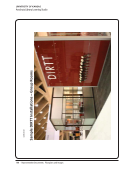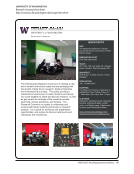SPEC Kit 327: Reconfiguring Service Delivery · 45
patrons about QR Codes, Apps that can be used to support academic work, use of blogs and wikis, and devices like
iPads, Kindles, and Nook e-readers. This group is still in startup and experimenting with these emerging technologies.
GIS services were existent prior to the reorganization, however, they are now aligned within the Specialized Content &
Services department, which is also responsible for supporting distance education through educational video capture
services. GIS, images, video, and music are now joined in this Specialized Content department.
The TFDL will be a very technology-rich environment when completed. For the initial opening of the Learning Commons
we had an increased use of self-serve checkouts, newly implemented RFID tagged materials, self-sorter for book returns,
a newly revised booking system for collaborative workrooms where students could select the room being booked (to
accommodate variations in technology), increased wiring and electrical outlet access, large displays and mini-Mac
servers in each of the collaborative workrooms to encourage collaborative work, TeamSpot software in collaborative
workrooms to further enhance the integration of student technologies with Learning Commons technologies. We also
introduced two touchable devices. Other signage and media walls were not fully implemented because of missing
mounts, these will be fully implemented in the fall. Students’ use of space substantial increase over old facility. Some
problems with abuse of the booking system that will be reviewed this summer. Expect to see more significant impacts
next fall when the facility is fully implemented.
This is anecdotal but by spending less time at a desk, librarians likely do have more time to explore and implement new
technologies such as QR codes and chat. We have implemented those but it wasn’t necessarily part of the decision to
reconfigure the service.
We implemented self-checkout in both the science/engineering and the social science/humanities libraries. So far, the
self-checkout hasn’t made a huge impact.
We were able to move to a model of hosted, streamed content and away from formats that may no longer be viable.
While not new, the availability of e-journals and electronic communication methods allowed the closure to move
forward.
While not part of the physical renovation of the first floor, part of the renovation funding went to the development of a
new media studio (five high-end media PCs and 14 iMacs loaded with state-of-the-art media software). Currently the
lab is located in the library annex building (attached to the main library building) within the Media and Reserves unit.
Our next renovation project will see the media studio and a technical support staff member move to the second floor
of the main building to enhance its profile. It will also be located nearby other service units and their staff so they can
assist students with the content/planning of their media projects.
Example 1: Collaboration and Outsourcing
11. If an opportunity for collaboration with a partner outside the library had a significant impact on
the decision to reconfigure this service, please briefly describe that opportunity and the impact it
had. If this did not have a significant impact, please enter NA for Not Applicable. N=52
39 responded NA.
patrons about QR Codes, Apps that can be used to support academic work, use of blogs and wikis, and devices like
iPads, Kindles, and Nook e-readers. This group is still in startup and experimenting with these emerging technologies.
GIS services were existent prior to the reorganization, however, they are now aligned within the Specialized Content &
Services department, which is also responsible for supporting distance education through educational video capture
services. GIS, images, video, and music are now joined in this Specialized Content department.
The TFDL will be a very technology-rich environment when completed. For the initial opening of the Learning Commons
we had an increased use of self-serve checkouts, newly implemented RFID tagged materials, self-sorter for book returns,
a newly revised booking system for collaborative workrooms where students could select the room being booked (to
accommodate variations in technology), increased wiring and electrical outlet access, large displays and mini-Mac
servers in each of the collaborative workrooms to encourage collaborative work, TeamSpot software in collaborative
workrooms to further enhance the integration of student technologies with Learning Commons technologies. We also
introduced two touchable devices. Other signage and media walls were not fully implemented because of missing
mounts, these will be fully implemented in the fall. Students’ use of space substantial increase over old facility. Some
problems with abuse of the booking system that will be reviewed this summer. Expect to see more significant impacts
next fall when the facility is fully implemented.
This is anecdotal but by spending less time at a desk, librarians likely do have more time to explore and implement new
technologies such as QR codes and chat. We have implemented those but it wasn’t necessarily part of the decision to
reconfigure the service.
We implemented self-checkout in both the science/engineering and the social science/humanities libraries. So far, the
self-checkout hasn’t made a huge impact.
We were able to move to a model of hosted, streamed content and away from formats that may no longer be viable.
While not new, the availability of e-journals and electronic communication methods allowed the closure to move
forward.
While not part of the physical renovation of the first floor, part of the renovation funding went to the development of a
new media studio (five high-end media PCs and 14 iMacs loaded with state-of-the-art media software). Currently the
lab is located in the library annex building (attached to the main library building) within the Media and Reserves unit.
Our next renovation project will see the media studio and a technical support staff member move to the second floor
of the main building to enhance its profile. It will also be located nearby other service units and their staff so they can
assist students with the content/planning of their media projects.
Example 1: Collaboration and Outsourcing
11. If an opportunity for collaboration with a partner outside the library had a significant impact on
the decision to reconfigure this service, please briefly describe that opportunity and the impact it
had. If this did not have a significant impact, please enter NA for Not Applicable. N=52
39 responded NA.






















































































































































































































